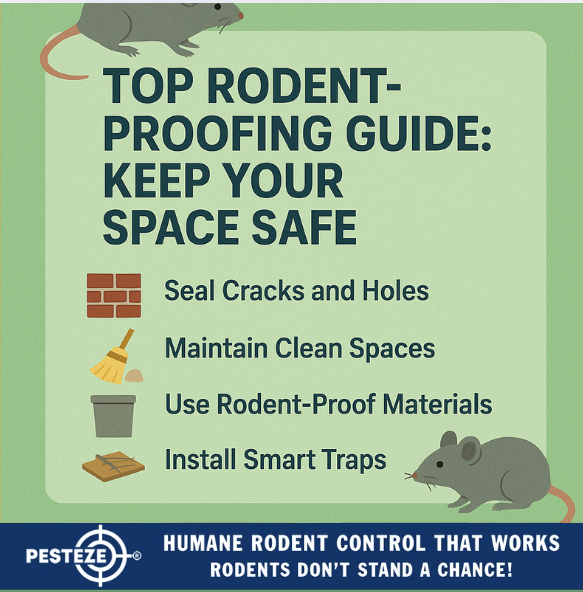TOP RODENT-PROOFING GUIDE: KEEP YOUR SPACE SAFE

TOP RODENT-PROOFING GUIDE: KEEP YOUR SPACE SAFE
SUMMARY
Rodents can cause serious issues for homes and businesses by spreading diseases, chewing through wires, and contaminating food. This guide offers effective rodent-proofing strategies that block entry, eliminate attractants, and maintain long-term protection to keep your property safe and secure.
FEATURES
Seal Cracks and Holes: Close off gaps in walls, floors, and foundations.
Maintain Clean Spaces: Keep areas free of food crumbs and standing water.
Use Rodent-Proof Materials: Store food in metal or thick plastic containers.
Install Smart Traps: Combine snap traps, bait stations, and monitoring tools.
Hire Pest Experts: Call professionals for large or recurring infestations.
Plan Regular Inspections: Prevent future issues with scheduled checkups.
GUIDE DESCRIPTION
Rodents are more than a simple inconvenience they represent a real threat to property and health. Mice and rats can squeeze through tiny gaps, contaminate surfaces with harmful bacteria, and damage wiring, insulation, and stored goods. Protecting your space starts with a strong rodent-proofing plan.
The first line of defense is sealing entry points. Rodents can slip through openings as small as a dime. Carefully inspect the perimeter of your home or business for cracks, holes, or gaps around pipes and vents. Use caulk, steel wool, or rodent-proof mesh to block access. Pay extra attention to basements, attics, and utility areas, as these are common rodent entry zones.
Next, sanitation plays a vital role. Rodents are attracted to food and water sources, so keeping spaces clean reduces their interest. Sweep floors, wipe counters, and store waste in tightly sealed bins. Fix leaky pipes or standing water issues to eliminate potential drinking sources.
Proper storage is equally important. Dry goods, pet food, and restaurant supplies should be kept in airtight containers made of thick plastic or metal. Cardboard and thin plastic are easy for rodents to chew through, leaving your supplies vulnerable.
For active infestations, trapping systems are necessary. Snap traps remain one of the most effective methods, but bait stations and modern electronic monitoring devices can enhance long-term control. If the problem is widespread, professional pest control services can provide targeted treatment and expert support.
Finally, prevention is ongoing. Even after rodents are removed, they may return if conditions remain favorable. Scheduling regular inspections ensures you catch warning signs early and can reinforce your defenses before another infestation takes hold.
By combining strong exclusion methods, sanitation practices, effective traps, and expert guidance, you can maintain a rodent-free environment. This layered approach protects your health, your property, and your peace of mind.
- Aahna Barma


Comments 0